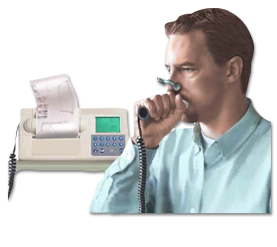One group (OCS group) received oral prednisone, 2 mg/kg (maximum of 60 mg/d) for 7 days, and placebo pressurized metered-dose inhaler (pMDI), four inhalations bid. The second group (ICS group) received flunisolide with a valved holding chamber (VHC), four inhalations (1 mg) bid for 7 days and daily placebo tablets. Patients were instructed in the use of the pMDI and VHC. Forest Laboratories prepared placebo inhalers, tablets, and the patient randomization sequence. Patients unable to swallow the tablets were instructed to crush the tablets into a suitable sweetened vehicle for oral administration. The pMDI canisters were labeled similarly and were indistinguishable with regard to taste. The researchers were blinded to the randomization codes throughout the study. 
On discharge, albuterol was administered on an as-needed basis for PEF of < 80% predicted. Each patient was given a TruZone peak flowmeter and instructed in its use. Asthma diary cards were also provided with instructions for recording symptoms and twice-daily PEF measurements. Patients returned for follow-up spirometry on day 3 and day 7 of the study period. FEV1 was measured using a portable spirometer. The best of three maximal expiratory curves generated by the patient were recorded in concordance with the criteria established by the American Thoracic Society. The study concluded on day 7 with the return of asthma diary cards and study drugs. The Institutional Review Board approved this study.
Data were analyzed using a Mann-Whitney U test for between-group comparisons of percentage of predicted FEV1, the primary outcome variable. Secondary outcome variables included symptom score, initial vital signs and oximetry, side effects, recurrence rate for acute asthma symptoms, and daily PEF. Student t test was used to compare means of normally distributed continuous variables. Nominal variables were analyzed by contingency tables. The sample size calculations used FEV1 as the primary outcome variable. We used data from previous studies, where FEV1 was measured in children with acute asthma and changes in pulmonary function in a placebo and treatment group Canadian pharmacy online. Assuming an a of 0.05 for a one-tailed test and a p of 0.05, we calculated a sample size of 44 patients would have a 95% power to detect a 20% difference in FEV1 or an 80% power to detect a 15% difference.